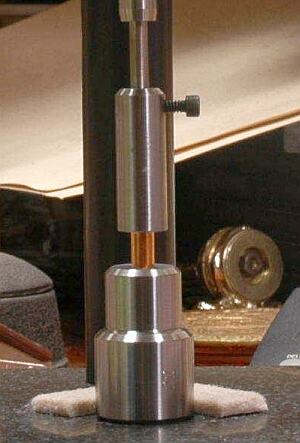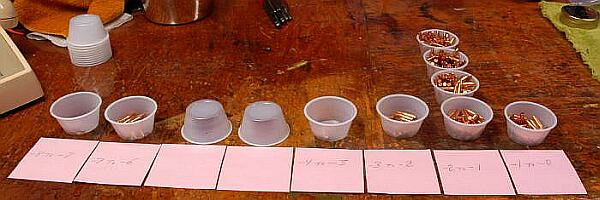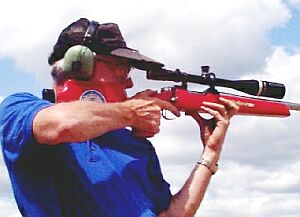|
Bearing Surface Comparator
Evaluation of Tubb BSC Tool with Sort Results
By Larry Medler, Anyrange@comcast.net
 Featured Selection from Featured Selection from
Rifle Silhouette Shooting
SUMMARY
Variations in bullet Bearing Surface (BS) can affect pressure and accuracy. Observed BS variations among tested bullets warrant segregating the bullets into Long and Short sub-groups. The Bearing Surface Comparator (BSC) allows BS sorting to be done quickly, precisely, and with good repeatability. It is a quality tool that performs an important task.
Why Does Bearing Surface Length Matter?
A bullet's bearing surface is the full diameter section that actually contacts barrel rifling. A longer bearing surface creates more friction which can lead to higher pressures. Also, when seating bullets close to the lands, large variances in BS can mean that some bullets engage the rifling while others do not, even with identical cartridge OAL. This can cause shot-to-shot pressure variances, increase Extreme Velocity Spreads (ES), and degrade accuracy, particularly at long range. Consistent bearing surface lengths help optimize ES and accuracy.Bearing Surface Comparators
I recently received my Bearing Surface Comparator (BSC) from Superior Shooting Systems (SSS), David Tubb's Company. Prior to receiving this BSC, I had been playing around with my Neal Jones 22 Rim Fire Headspace Checker to measure bullets. I have two special inserts that allow me to measure 22-caliber and 30-caliber bullets. I have measured 1000 bullets using the Neal Jones Tool, one 500-count box of 80gr 22-caliber MatchKings and one 500-count box of 175gr 30-caliber MatchKings. Using the Neal Jones gauge, I was able to separate both boxes of bullets into distinct bearing surface length groups. The measurement using the modified Neal Jones gauge includes the boat tail length, so I decided to give David Tubbs Bearing Surface Comparator a try. First to be processed through my new BSC were the same Sierra 30-caliber 175gr MatchKing bullets that I had separated into basically two groups using my Neal Jones tool minus 100 bullets from one of the groups which I had loaded and was unable to re-check.
The BSC is a pretty slick setup, easy to use and quick. The BSC costs $134.95 for a single caliber set-up with dial indicator, plus $34.95 for each extra caliber insert. The first bullets (400) I measured had been pre-measured and sorted using my modified Neal Jones 22 Rimfire Headspace checker with a 30 caliber bullet insert. Using the Tubb BSC it was very easy to refine the separation on the 400 bullets into groups with 0.001" incremental differences in the bullets' bearing surface length.
When I used the Neal Jones gauge, I was able to sort the 500-count box of bullets into basically two piles. When checking the bullets using the Neal Jones sliding scale, the group of bullets with the longer bearing surface length would only use the first couple of numbers on the scale with a few too long even to be measured. On the other group of bullets with the shorter bearing surface length, the slide on the Neal Jones Tool would go all the way to the last couple of higher numbers and sometimes off scale. So I just made two piles out of the box of 500 bullets. Meanwhile I have used or loaded 100 from the group with the longer bearing surface measurement. A couple of weeks later I measured the remaining 400 bullets again using the BSC. I was surprised that I still basically had the same two piles. All of the bullets that I measured with longer BS with the Neal Jones gauge were all within a couple of thousandths and almost all that I checked as being a little shorter with the Neal Jones gauge also stayed in the shorter piles using the Tubb BSC. That is all but five of the shorter ones, so I either measured five wrong or placed five in the wrong pile. I will just say that I measured five shorter as being longer using the Neal Jones gauge. After all it is pretty hard to measure a longer one short and that is my story.
 Measuring and Sorting Measuring and Sorting
Using the BSC I separated the bullets by .001" increments. This was much easier and much more repeatable than using the Neal Jones gauge. The two distinct bullet groups were 7 to 8 thousandths apart and there was an .003" gap between the two groups. Comparing the Neal Jones verses the Tubb BSC, the BSC is the clear winner and it beats my Neal Jones gauge hands down. What is interesting and significant is that the variation I have seen so far all seems to be in the surface zone and not in the boat tail. This is good news. It would be pain to measure and sort every bullet by the spoiler length.
 BSC Operating Tips BSC Operating Tips
My setup includes a locator for the bullet insert you place under the dial indicator. I put a little v-shaped felt locator on the surface plate to quickly center the bullet-holder under the dial indicator. With the base unit properly centered, I just let the indicator insert come down on the bullet boat tail and then I slightly turn the lower insert with bullet to get a reading.
The needle on the dial indicator settles right down to well under one thousandth of total movement while slightly turning and that is when I decide into which pile the bullet would go. The BSC setup works great; it's much easier and faster than trying to use a modified Neal Jones gauge.
 One other thing surprised me with the BSC. That is the set screw which holds the insert onto the dial indicator stem was the same size #6-32 set screw that is used on Leupold Scopes' target knobs. Lots of silhouette shooters replace these screws with a longer cap-head screw and then never worry about striping the socket head on the set screw inside the scope knob. I just happen to have a life-time supply of these longer #6-32 hex cap head screws. So the longer 3/8" cap-head screw is used on my BSC also. The longer screw makes a great little handle to raise and lower the insert. One other thing surprised me with the BSC. That is the set screw which holds the insert onto the dial indicator stem was the same size #6-32 set screw that is used on Leupold Scopes' target knobs. Lots of silhouette shooters replace these screws with a longer cap-head screw and then never worry about striping the socket head on the set screw inside the scope knob. I just happen to have a life-time supply of these longer #6-32 hex cap head screws. So the longer 3/8" cap-head screw is used on my BSC also. The longer screw makes a great little handle to raise and lower the insert.
The Results Were Remarkable
The picture and table below show more of my bullet-sorting results using the BSC. The picture shows the little cups into which I placed the sorted 77gr 22-caliber MatchKings. In front of each cup is a Post-It marked with the dial indicator range. The cups are small enough that I can weigh a cup full of bullets on my digital scale and get the bullet count per cup by just dividing the results by the bullet weight. This little trick was devised after I finished with that first 400-count group of 175 SMK bullets.
The 175gr and 77gr bullets in the table below were not pre-sorted using the Neal Jones gauge and both sets are also the remaining portion of a 500-count box of bullets. After playing around for a while I decided to use the shortest bearing surface length as the base measurement and relate all others as plus to the base measurement in .001" increments. This allows easy comparison between different lots, calibers, and brands of bullets.
| Bullet Caliber | 30 Cal | 22 Cal | 22 Cal | | Tested Bullet Weight | 175 Gr SMK | 77 Gr SMK | 80 Gr SMK
(Pre-Sorted) | | Shortest = Base Length | 3 | 3 | 40 | | Base Length plus 0.001 | 15 | 12 | 132 | | Base Length plus 0.002 | 29 | 0 | 74 | | Base Length plus 0.003 | 1 | 0 | 80 | | Base Length plus 0.004 | 11 | 2 | 2 | | Base Length plus 0.005 | 38 | 15 | 0 | | Base Length plus 0.006 | 92 | 207 | 16 | | Base Length plus 0.007 | 17 | 27 | 0 | | Total | 206 | 266 | 344 |

Both the 175gr and 77gr samples in the table show one predominate group with a slightly longer bullet surface bearing length and a second smaller group with shorter bearing length. Loading and shooting the sorted bullets separately surely can not hurt anything or make things worse. In the third column are the remaining bullets from a 500-count box pre-sorted using the Neal Jones gauge. This box of 80gr bullets also had two or more distinct groups. When I load the sorted bullets, I just start at one end. I also shoot them in the same order so shot-to-shot variations in bullet bearing surface are minimized. I have loaded some of the bullets with the longer bearing surface length and this box had a greater spread than shown.
The 400 Sierra 175gr MatchKing bullets that I first measured (not shown on the table) were from another box with a different lot number and that box also showed two distinct BS length groups. So my initial results of sorting with either the Neal Jones gauge or the more accurate BSC both yielded similar results, i.e. there were two distinct bearing surface lengths in each box of bullets. One wonders what effect the differing BS lengths would have on ES and accuracy. I conclude that sorting by bearing surface length surely cannot make things worse and this may be one important step in reducing those so-called flyers. After all David Tubbs does it, and he's won a few trophies over the years.
Conclusion: The Tubb BSC Works Well and Achieves Important Results
My bottom line for the BSC is that it is easy to use and gives very repeatable results. I found the BSC is about five times faster to use than my modified Neal Jones gauge and the Neal Jones gauge works about twice as fast as using a vernier caliper with couple of comparator inserts attached to it. I can have two pills in the cup while you are still reading the vernier caliper. The actual benefits of this additional step (and the time spent doing it) are open to question. Often the time involved with activities such as these may be as useful as range practice. Mental conditioning is also part of the shooting game and the reloading process may be incorporated into this mental conditioning. So while doing some of these seemingly meaningless operations--cleaning primer pockets, turning necks, etc. with little measurable benefit--if one thinks about those good shots of the past and dreams of great shots in the future, then the time may not be wasted at all but may actually be good mental “R&R”. The BSC process also fits into my way of thinking--if you can separate a big pile of something into smaller meaningful piles, using some sort of valid measurement technique, it has to make things better. Whether this additional step in the reloading process produces measureable accuracy gains or not is another story. But we do know that many very successful shooters sort their bullets by bearing surface length, and their results in competition strongly suggest such sorting DOES enhance accuracy, particularly at long range.
So far I'm very happy with my BSC and wish that David Tubb never told me that the tool could be used on loaded ammo too! That's just what I need--yet another way to sort ammo I thought was ready to go.
-- Larry Medler

Test with Modified Neal Jones Gauge showing similar Sierra MK bearing surface sort results.
David Tubb's Bearing Surface Comparator Page
Orange Blossom Regional 2005 Ballistics.
(This is a special printing of Silhouette Ballistics for the 2005 OBR Matches.)
Tubb BSC Instruction Manual
(Click image to download .pdf file).

Copyright © 2005, Larry Medler and 6mmBR.com, All Rights Reserved. Top three photos Copyright © 2005, DavidTubb.com, used by permission. No reproduction without written permission.

|